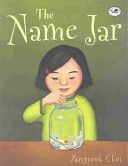
The Name Jar
Written and Illustrated by Yangsook Choi
Dragonfly Books, 2001, 40 pp.
ISBN: 9780440417996
The Name Jar was written and illustrated by Yangsook Choi, a Korean American who currently resides in New York City. Choi has received numerous awards for The Name Jar, including the IRA Teachers’ Choice designation, Chicago Public Library Best of the Best designation, and California Young Reader’s Medal nomination. The book is based on one of Choi’s experiences when moving to the U.S. In the story, the character, Unhei moves from Korea to the United States with her family. Worried she will be teased because of her hard-to-pronounce Korean name “Yoo-hey,” Unhei decides to adopt an American name. When Unhei’s classmates try to help her find a new name; they give her a glass jar full of American-style names. However, when Unhei begins to think about the new names, she realizes what it will really means to give up her name and all that it means. Unhei realizes that the best name for her is the one she has because it is her name and fits her best.
The story is age-appropriate for younger students and makes allusion to weightier issues immigrants face while transitioning to a new life. A name change may appear as an exterior change, but is representative of the numerous internal shifts immigrants make in assimilating to a new home. Two questions among many immigrants face when relocating are: What do we culturally keep? What do we leave behind? Unhei decides that her name is one facet of her life she will keep despite its unusualness in America. The story’s ending may be predictable, but Unhei’s thoughtfulness regarding a possible name change demonstrates reflection, personal strength and cultural pride. Name changes can have deeper implications beyond self; a name change can affect an individual’s family and cultural identity. When the children in the book suggest that Unhei shut her eyes to draw a name from the jar, Ralph points out, “What if she doesn’t like the name she draws?” Rosie counters, “Well, we didn’t get to choose our names when we were born, did we?” These statements along with Unhei’s reflection of changing her name provide an opening for students to consider their names on a deeper level.
The story’s cultural details and authenticity are evident in Choi’s use of Korean names, Korean signs and food boxes at Mr. Kim’s grocery store, traditional furnishings and decorations at Unhei’s home, and the name stamp Unhei’s grandmother gives her, meaning Grace. Criticism regarding Unhei’s use of proper English on arrival in America or that she does not switch languages when she is at home or speaking to Mr. Kim may be a concern with regard to authenticity. Those aspects may have been sacrificed in order to provide a more accessible read for the general public.
Choi grew up in Korea but moved to the United States as a young adult to pursue an education and career in art. She attended school for two years at Kendall College of Arts and Design in Michigan prior to moving to New York City and attending the city’s School of Visual Arts and eventually earning an MFA in illustration. Choi grew up doodling on paper. Her practice of doodling was looked upon as a waste of time and the habit labeled her as lazy in the eyes of adults. In Korea students were expected to study and work at achieving good grades rather than spend time drawing. Choi wanted to live a place that took her illustrations seriously and where she could learn her craft and grow as an artist. Choi chose to leave Korea and move to the United States in order to pursue her passion for illustrating.
Choi enjoys creating children’s books and sharing her talent with others. She gives equal stock to her writing and illustrating processes. Choi’s writing and illustrations begin with the use of a notebook for collecting ideas, whether in words or sketches. Reading as much as possible on a topic or idea is also part of her creative process. Once Choi gathers enough material she states, “I think about how all those pieces can come together” to create a story. Choi notes that “even when I don’t have enough for an entire story, if I have a solid idea for a character or an ending, then to me that’s enough to start writing.”
Choi’s style of illustrating includes the use of bold, vibrant colors that often use the entire page. Her illustrations have been described as having “characteristically expressive close-ups of faces,” and art that “enhances her depth of characters,” and “captures expressions on the faces of her characters.” Understandably, Choi’s representation of a character’s nature is one of her strong suits as an illustrator. Her unique artistic identity provides a visually appealing story that adds to and reinforces the written story.
The Name Jar can be paired with other books that deal with issues of children immigrating, fitting in, or other books illustrated by Yangsook Choi. A book to pair with The Name Jar that has to do with immigration and change of a name is My Name is Yoon by Helen Recorvits (2003). Another book to pair with The Name Jar that has a twist about how one fits in culturally is Apple Pie Fourth of July by Janet S. Wong (2006). Lastly, several books illustrated by Yangsook Choi that deal with both immigration and/or fitting in are Landed by Milly Lee and illustrated by Yangsook Choi (2006) and Good-bye 382, Shin Dang Dong by Frances and Ginger Park and illustrated by Yangsook Choi (2006).
Megan McCaffrey, Governors State University, IL
WOW Review, Volume VII, Issue 4 by Worlds of Words is licensed under a Creative Commons Attribution-NonCommercial-ShareAlike 4.0 International License. Based on work at https://wowlit.org/on-line-publications/review/vii-4/
